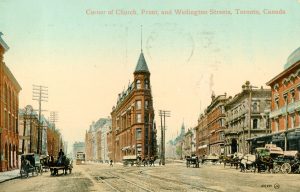Valentine & Sons of Dundee were Scotland’s most successful commercial photographers. In the early 1900s, at the height of the postcard craze, they published large numbers of postcards in the U.K., Canada, U.S., Australia and South Africa. Even though enthusiasm for postcards eventually waned, Valentine & Sons continued to produce cards into the 1960s and 1970s.
The U.K. Company
Remembered today primarily as postcard publishers, Valentine & Sons was a printing and photography business in Dundee, Scotland. It was founded in 1825 by John Valentine and was expanded by his son James, who had studied the daguerrotype process in Paris in the 1840s and was consequently able to add the important element of photography to the company’s offerings in the year 1851. By 1890, the company reportedly had amassed upwards of 40,000 photographic negatives representing scenes from all over the world.
Postal stationery was long a Valentine specialty: in a 1905 advertisement, the company claimed to have produced “pictorial envelopes” over 60 years earlier (i.e. prior to 1845). And as early as 1850, the company was proposing a design for “ocean penny postage”, which — as illustrated below — anticipated many of the elements of the postcards that were to emerge several decades later. The idea of ocean penny postage, as illustrated in the design, was to encourage the development and maintenance of ties among Britain’s Imperial subjects across the far-flung Empire, which illustrates the important truth that the postcard was conceived not as a mere frill or fancy but rather as the product of strategic thinking about the commercial and political importance of frequent and affordable communication.
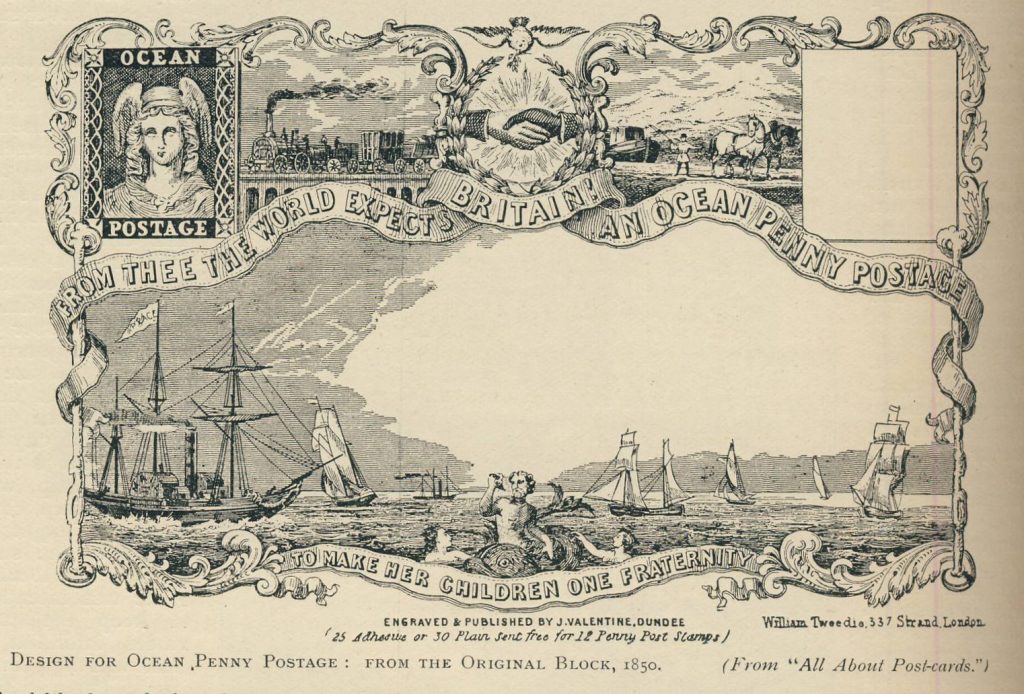
Proposal for “Ocean Penny Postage” (1850), from Scott’s All About Post-cards, reproduced in The Picture Postcard and Collectors’ Chronicle (October 1903, no. 40), 250.
By the 1860s the company had begun to cater to the growing tourist industry by producing photographic prints with views from around the country. After James’s death in 1880, his son William Dobson Valentine took over the ever-expanding business. Valentine & Sons converted from a partnership of the family members to a joint-stock company in 1896, the year in which it is said to have issued its first postcard. By 1907 — according to an article in the Canadian Druggist, a trade publication — its factories in Dundee and Edinburgh employed 700 people and were turning out 3,000,000 postcards every week. As early as 1904, the company advertised that its “Valentine’s Series” cards included “upwards of 50,000 Different Views representing every town and beautiful scene in Great Britain.” The operation continued until 1980 when the last remnants of the business were sold off to Hallmark, Inc.
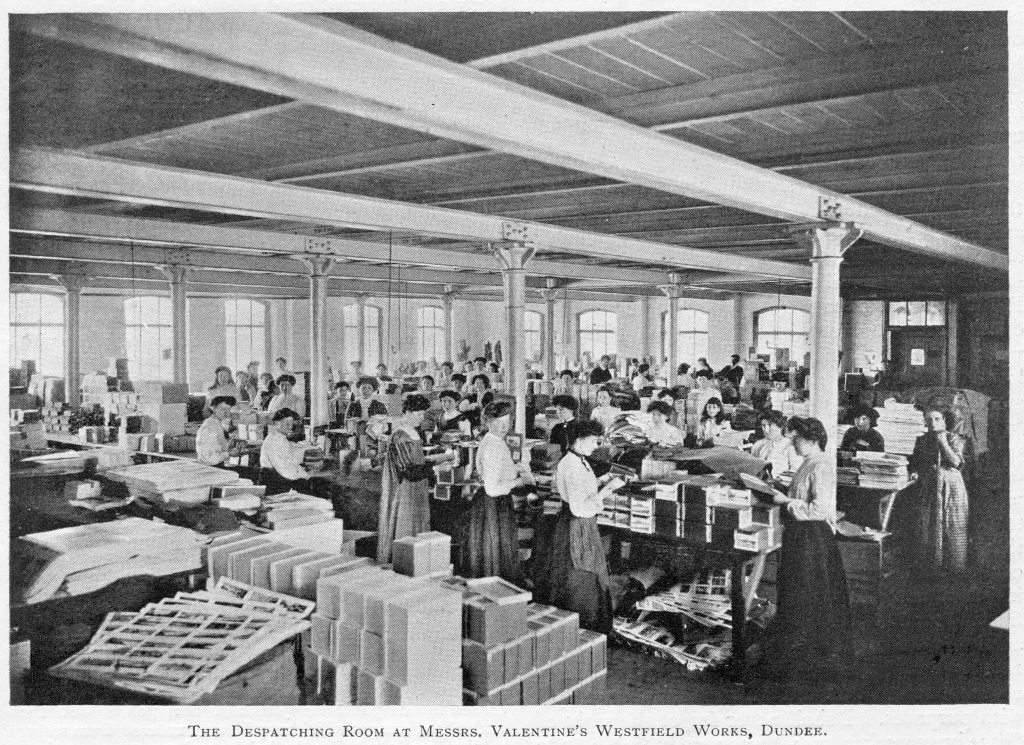
The Despatching Room at Messrs. Valentine’s Westfield Works, Dundee. In this 1905 image we see uncut sheets of V&S postcards and a female workforce apparently packing the customers’ orders.
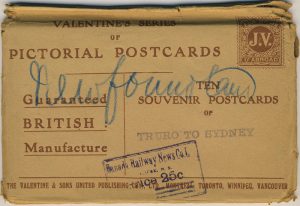
A postcard packet. Lithographed postcards by Valentine & Sons and other publishers were often purchased in sets. In this case, Valentine & Sons has packaged 10 cards showing scenes along the railway route from Truro to Sydney in Nova Scotia, for purchase aboard the train. The Canadian Railway News Co., whose stamp is visible on the envelope, sold the package aboard the train for 25 cents. Valentine appealed to patriotic Canadian buyers by assuring them of “British Manufacture”, while most of its rivals sold cards printed in Germany.
The Company’s Arrival in Canada
Nowhere other than in their home country (and possibly not even there) were Valentine & Sons as successful as they were in Canada. The Dundee company and its Canadian successors appear to have produced more postcards in Canada, in a far greater number of distinct designs, than any of their rivals. Despite this, the Valentine & Sons story is not that much different than those of most of the company’s lesser competitors: it is difficult to piece together and especially murky in respect of the business’ early years (which we discuss in more detail, if somewhat speculatively, toward the end of this article).
The firm’s Canadian business began with the arrival of George Clark, a commercial traveller sent over by the main office, in Montreal. That was in 1903. Company representatives were soon sent to Toronto and Winnipeg as well, with the photographer Maurice Lyall (a native of Montrose, near Dundee, and later the creator of thousands of real photograph postcards) serving for a time as the company’s Manitoba representative. The Toronto operation grew into an office at 69 Adelaide Street East with a handful of employees. In 1912, full-service offices opened in Winnipeg and Vancouver.
The Canadian postcards
Valentine & Sons produced postcards of all Canadian provinces, although there were only a handful from Newfoundland & Labrador, which was not a part of Canada in that era. The earliest Canadian postcards published by Valentine & Sons were uncoloured collotypes of scenery along the main line of the Canadian Pacific Railway north of Lake Superior and in the Rocky Mountains. We discuss some of our research into the early cards at the end of this article. Typically, Valentine & Sons postcards have a 6-digit serial number (###,###) on the view side with the initials “J.V.” in a circle adjacent to that number. The main series of numbering begins with a Halifax card as no. 100,000 and ends (as far as we know) with a postcard of Toronto as no. 115,981 (see image in this article). There are also two short runs of numbers in the 400,000 range that are found on some cards from the Yukon Territory and a longer run of views from various parts of Canada that begins at 600,000 and continues past 602,000. The 600,000+ cards appear to have been mainly cards produced for other sellers or as commercial promotions which, as a consequence, often omit any attribution to Valentine & Sons itself.
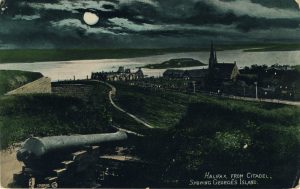
Halifax, from Citadel, Showing George’s Island. Valentine & Sons no. 100,001, the second postcard in the Canadian company’s principal numbered series. This version has been turned into a “moonlight” view by Valentine’s artists.
Speaking very generally, the earlier Valentine & Sons cards — numbered from the 100,000s through the 105,000s — tend to be more common, while the later, higher, numbers are significantly more likely to be scarce. It is important to realize that the Valentine number refers to the image on the postcard and not to the card itself. In other words, if (for example) an image was published once, then re-published on a card with a different border design and then issued in a “moonlight” version (i.e. a card coloured to look as though the photo was taken at night, in the moonlight), all three of those cards will have the same Valentine number. That is one reason that it is unlikely that we will ever be able to say with certainty how many Canadian Valentine & Sons cards were printed. Even if we succeeded in associating all of the numbers in each of the sequences with an image, it would be nearly impossible (in the absence of company records) to know how many “variants” were produced from each of those images. Moreover, some Valentine postcards are unnumbered, e.g. the “multiviews” — essentially collages of multiple images — that the company produced in relatively large numbers.
In another unusual wrinkle, there are also a number of Canadian Valentine & Sons view cards in which an old image of a scene was swapped out for an updated one, while the postcard kept the same caption and number. These duplicates are difficult to identify.
A brief note on Valentine & Sons postcards from other countries
Other numerical ranges belonged to Valentine & Sons’ branches in other countries, as follows: USA – 200,000s; Australia – 300,000s; and South Africa – 500,000s. New Zealand cards were produced but these seem generally to have been numbered in the U.K. series, which bore numbers less than 100,000.
The Canadian division becomes independent (1909), splits into two (1926)
In 1909, George Clark, Percy McIntosh Black and a number of others in Montreal bought out the Canadian Valentine & Sons operation, incorporating it as the Valentine & Sons United Publishing Company, Limited. In 1926, the Canadian company split into two: the Toronto-based Valentine Black (under Percy Black) and the Winnipeg-based Valentine Edy (under J. C. Harrington Edy). The two companies continued to reproduce some of the existing images, but Valentine Edy, in particular, adopted new numbering systems in its later years. The Valentine Edy Co. ceased operations in 1957, followed by Valentine Black in 1964. The Vancouver office, it should be noted, existed only from 1912 to 1919, although E. P. Chandler, a photographic supplies dealer, had reportedly been the company’s original representative in British Columbia from around 1908 or 1909, according to an account in the Vancouver World newspaper in 1910.
Valentine & Sons in the Canadian Context: Then and Now
As noted above, Valentine & Sons cards are by far the most common “Golden Age” postcards found in Canada. Because “familiarity breeds contempt”, these attractive cards are not always given the credit they deserve. Many of the cards are inexpensive, primarily because they are so common, but others are quite scarce and relatively valuable. Thanks to the prolific production of Valentine & Sons, it is possible to assemble a sizeable collection of good-quality postcards from nearly any region of Canada quite inexpensively. The advertisement below, which appeared in the Canadian Druggist in 1907, gives a sense of Valentine & Sons’ strong position in the market and multitudinous offerings.
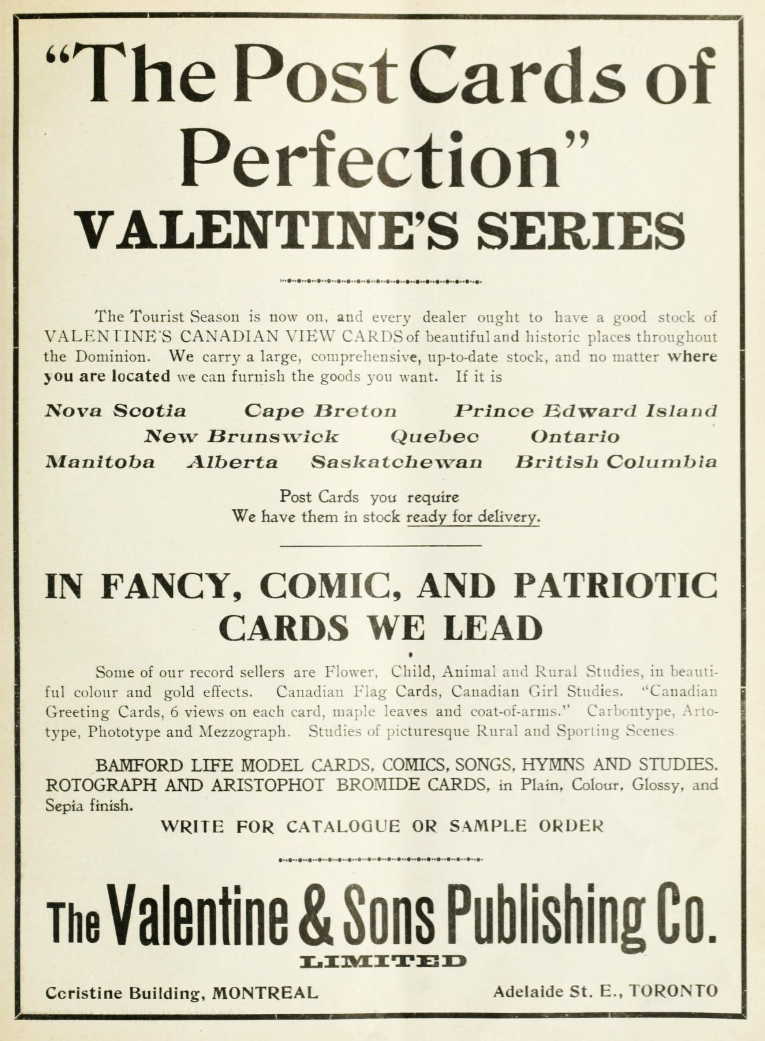
Advertisement from the Canadian Druggist, 1907, emphasizing the comprehensive nature of Valentine & Sons’ offerings, both geographically and topically. Click to enlarge
Dating Valentine & Sons’ Canadian Postcards
As a rough guide, the following list gives an idea of the time period represented by the main Canadian Valentine & Sons series, divided into “thousands”. The dates indicated are the earliest postmarks observed in a sample of Valentine & Sons postcards from a private collection. There is no claim that the dates in the list are the earliest, but in many or most cases, they should be close to the earliest date. Other indicators of the time period include: the style of the front – does it have the “classic” early V&S look – if so it’s 1905-1915ish; does it have a white border – then it’s late 19-teens or later; is it a “Valentine Black” or “Valentine Edy”? – the successor companies that replaced Valentine & Sons Canada in the 1920s.
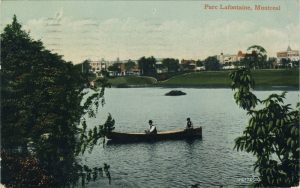
Parc Lafontaine, Montreal. Valentine & Sons no. 102,177. This illustrates the typography, colour palette and characteristic “look” of the most common type of Valentine & Sons postcard. Note the circled “J.V.” next to the number at lower right.
- 100,000 – 1905 (July)
- 101,000 – 1906 (August)
- 102,000 – 1907 (January)
- 103,000 – 1908 (August)
- 104,000 – 1909 (July)
- 105,000 – 1910 (January)
- 106,000 – 1911 (January)
- 107,000 – 1911 (December)
- 108,000 – 1912 (August)*
- 109,000 – 1913 (January)
- 110,000 – 1913 (October)
- 111,000 – 1914 (August)
- 112,000 – 1918 (March; in this sequence, we begin to see white border cards and cards by Valentine-Black)+
- 113,000 – 1927 (January; a Valentine-Black card)
- 114,000 – 1931 (June; very few recorded uses) +
- 115,000 – 1922 (July; all in sample are Valentine-Black)
- 600,000 – 1908 (March; many of these were published for other publishers or were made as promotional items for the depicted businesses)
- 601,000 – 1909 (December; ditto)
- 602,000 – 1927 (September; the highest number found to date is 602,037, so there are very few cards in this range. Nearly all of them are Valentine Edy cards from Manitoba and Saskatchewan)
*Thanks to TPC members Jack Cline and Ken Elder for dating information on the 108,000+ sequence, which seems to have been distributed beginning in the summer of 1912. A (+) indicates that the date given has recently (as of July 2021) been changed to reflect new information about earlier dates.
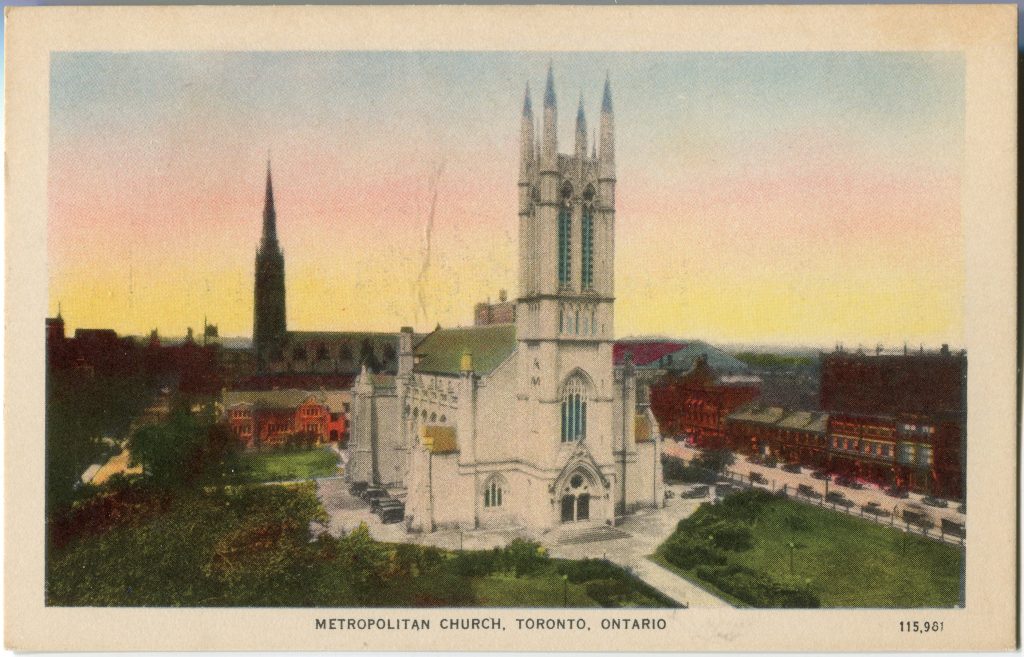
Metropolitan Church, Toronto, Ontario, no. 115,981. This is the last known number in the principal Canadian series of Valentine & Sons postcards that began with no. 100,000.
Early Valentine & Sons Cards
The first few years of Valentine & Sons’ business in Canada are still shrouded in mystery. Postcard dates prior to mid-1906 are uncommon. While examples of postcards with V&S images and numbers have been found postmarked in the first half of 1905 (as early as 19 April), those cards seem invariably to be Canadian Pacific Railway-branded “Canadian Souvenir Post Cards” that used V&S images but which were not otherwise identified with the company. The earliest Valentine & Sons-branded postcard that we have found to date is a collotype of card no. 100,356, “Normal School, Toronto”, which has a manuscript date of “7/28/05” (28 July 1905). Another early use in TPC members’ collections is a copy of no. 100,208 “A String of Beauties, Granite Lake, Temagami District, Ontario” that is MS. dated “August 1905”. The earliest known postmark — 5 August 1905 — is found on a British “Valentine’s Series” card of St. Paul’s Church in Halifax. These cards were not “Canadianized” for the market but were apparently sold in Canada as this example was mailed in Halifax on the afternoon of 5 August 1905. Other early versions of Halifax cards in this same series have been noted and it may have been the “trial run” for the company’s Canadian efforts. Like those other cards, this one has no number, although subsequently the image appeared as “100,004” on many Canadian V&S cards.
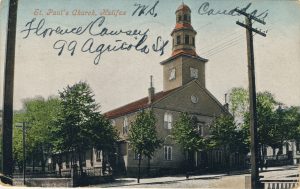
St. Paul’s Church, Halifax. Postmarked 5 August 1905 to Bolton, England, apparently part of a postcard exchange with the woman who has written her address “99 Agricola Street” on the face of the card.
The earliest known postmark on a Valentine & Sons card with a Canadian back — 1 September 1905 — is on the example of no. 100,348, “University of Toronto – Medical Building”, shown below. Those postcards, like a number of others from the late summer and early fall of 1905 bear the “Printed in Scotland” notation (as shown below). The fact that they include cards in the 100,2xx and 100,3xx ranges suggests that the initial issuance of cards was in the hundreds. We have also seen a number of early cards with the CANADIAN POST CARD back (also shown below), but these have so far been found to date only to October 1905 at the earliest.
Update: An earlier mailing has been identified, no. 100,361 — “Toronto Street and Post Office, Toronto” — postmarked 21 July 1905 at Alexandria Bay, New York. That location suggests that the cards may have been sold, in the summer of 1905, aboard passenger vessels in Lake Ontario.
The U of T Medical Building card not only has the “Printed in Scotland” notation, but also italic captioning and a statement relating to the countries that were then accepting written messages. The italic captioning style was used occasionally in a few subsequent V&S Canadian printings, but, to the best of our knowledge, the list of countries never appeared again.
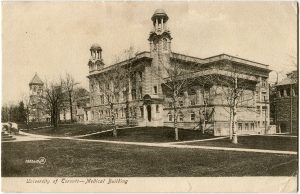
University of Toronto – Medical Building. This scarce example, from what was probably the first printing of Valentine & Sons-branded Canadian postcards, features an italic caption typeface rather than the familiar roman typeface of most later V&S printings. The card is no. 100,348.
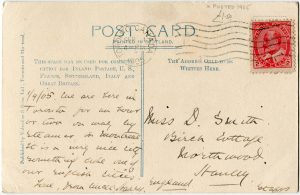
University of Toronto – Medical Building (reverse). Postmarked TORONTO CANADA SEP 1 1905 4 PM (1 September 1905), with a positive comment about Toronto from an English visitor, this very early back — possibly the first that the company used for its own postcards in Canada — includes the words “PRINTED IN SCOTLAND” beneath the POST CARD heading.
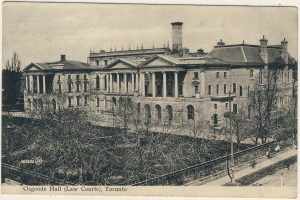
Osgoode Hall (Law Courts), Toronto. Valentine & Sons, no. 100,353. This postcard is in the style of many of Valentine & Sons’ earliest Canadian postcards — untinted high-quality collotypes. Many of the earliest images were by William Notman, but there is no indication that the Osgoode Hall photograph was.
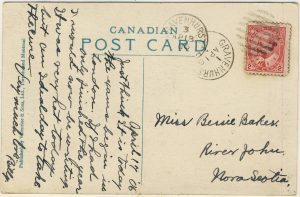
Osgoode Hall (Law Courts), Toronto (reverse). This example shows one of the company’s earliest Canadian back designs. The card is postmarked GRAVENHURST ONT. AP 18 06 (April 18, 1906) and unusually sports a 2c stamp, exceeding the required postage by a penny.
For More Information

Birds Eye View of Moose Jaw, Sask., looking North. Valentine & Sons, unnumbered. This is a rare bifold (two-panel) postcard by the company. Unusually, the photographer (Alfred Sutton) is identified in the caption.
The most complete list of Valentine & Sons postcards is on our “lists” page. Click here for more information. Please contact us if you have any pieces to add to the puzzle!
Valentine & Sons on Wikipedia
University of St. Andrew’s (Scotland) Photographic Archive
Luminous Lint: a website with a James Valentine biography and photo archive

